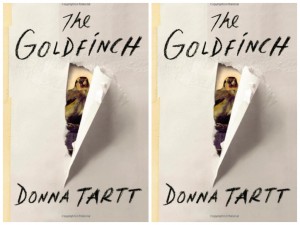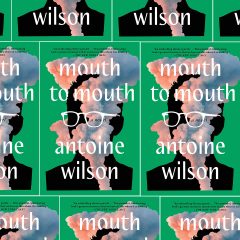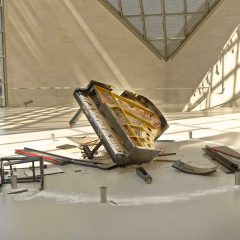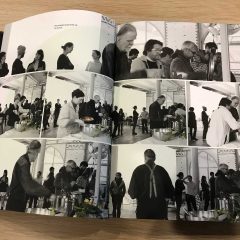[Libby wrestles with the length of celebrated novel The Goldfinch, but ultimately concludes it’s worth the read. — the artblog editors]
Forget about the eponymous Fabritius painting. The reason I tore through Donna Tartt’s bestselling, mega-sized novel The Goldfinch is the almost Dickensian tale of a boy unmoored from his family and drifting through households and locales in a surreal state of drug-and-alcohol-induced stupefaction, all the while holding on to that invaluable painting, “The Goldfinch,” packed in a pillowcase.
The painting of the bird is real–a small, rare 17th-century Dutch masterpiece housed in the Mauritshuis in the Hague. In the fictional world of the book, the young hero takes the painting from the Met during a terrorist attack. The act is as much a rescue as a theft. He and the painting are survivors, and he holds on to it for dear life, as a talisman and a burden. The book is about the boy and the painting finding their true home.
The Goldfinch‘s captivating allegory

The novelist herself uses the painting as a guide to navigate irreconcilable dualities–good and evil, hope and despair, safety and danger, perfection and flaw, life and death, a wager and a sure bet. Young Theodore Decker, having escaped the terrorist explosion, then escapes foster care in The System. However, he does not escape a move to Las Vegas, when his missing father–immature, irresponsible, a gambler and a crook–shows up in New York City with his girlfriend to transplant Theo to one of the few occupied houses in a failed real estate development slowly returning to sandy desert. It is here that Theo meets his best friend, who is also his worst friend, and begins a career of drugs and dishonesty.
As a reader waiting to find out if and how Theo will return the painting and reunite with all of the people in Manhattan who took care of him before his father showed up, and then waiting to find out if Theo will escape the Feds, a pair of blackmailers, the Art Police, and the “best friend” who has ties to the Russian mob–all of that was enough to keep me riveted through far too many detailed, multi-page descriptions and endless interior monologues–not that the propulsive, unweeded language doesn’t have a beauty and life of its own. It just calls for an editor.
In the course of racing through time and place as Theo grows up, I learned a little about things of which I knew nothing–baccarat; the good, the bad and the ugly sides of the antique furniture business; and the international underworld of missing art (not sure if this was really how it is, but I believed it).
At the end, the novel turned out to be a sort of philosophical exposition about the transcendence, meaning, and value of great art. That’s not to say that these concepts weren’t set up earlier, but by time they came thudding down on me, I almost laughed.
All of which is to say: I was a little skeptical about the author’s search, in the gap between the trompe l’oeil effects and the literal daubs of paint, for the GREAT ANSWER to life’s questions. I probably would have fallen for the romanticism of it all if the summation had been laid out in 100 words or fewer. And yet I read every word of those nearly 800 pages, in a book that, like its namesake painting, exists in the space between artifice and literal reality. Believing in a book is like looking at visual art. You take a risk to swim in another universe and suspend your disbelief, to satisfy a yearning. This book provided that experience almost perfectly.









